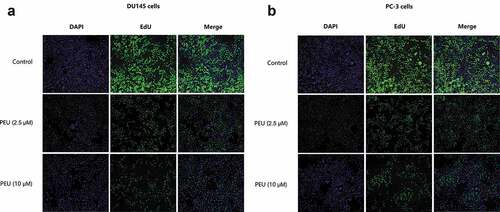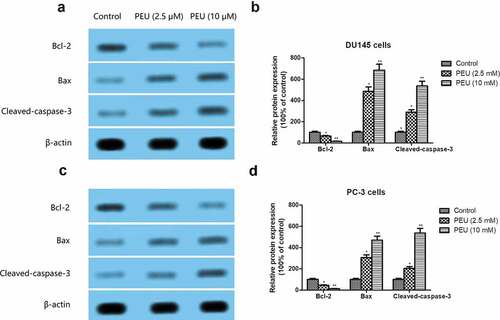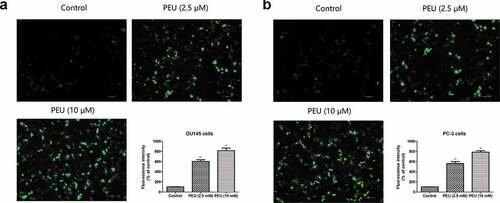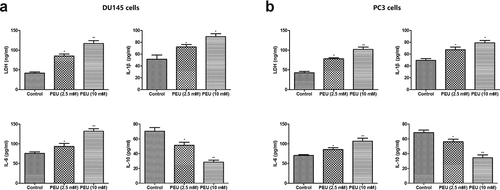Figures & data
Figure 1. Effect of PEU (0, 2.5, 5, and 10 μM) on the cell viability of different prostate cancer cells. (a) Effect of PEU (0, 2.5, 5, and 10 μM) on the cell viability of androgen-independent DU145 cells; (b) Effect of PEU (0, 2.5, 5, and 10 μM) on the cell viability of androgen-independent PC-3 cells; (c) Effect of PEU (0, 2.5, 5, and 10 μM) on the cell viability of androgen-dependent LNCaP cells; (d) Effect of PEU (0, 2.5, 5, and 10 μM) on the cell viability of normal human prostate epithelial PrEC cells. Results are expressed as the means ± SD of three separate determinations. *P < 0.05 and **P < 0.01 compared with control cells

Figure 2. Effect of PEU (0, 2.5 and 10 μM) on the cell viability of prostate cancer cells evaluated by BrdU cell proliferation assay kit; (a) Effect of PEU (0, 2.5 and 10 μM) on the cell viability of androgen-independent DU145 cells evaluated by BrdU cell proliferation assay kit; (b) Effect of PEU (0, 2.5 and 10 μM) on the cell viability of androgen-independent PC-3 cells evaluated by BrdU cell proliferation assay kit

Figure 3. Effect of PEU (0, 2.5 and 10 μM) on the apoptotic cell death of prostate cancer cells. (a) Effect of PEU (0, 2.5 and 10 μM) on the apoptotic cell death of androgen-independent DU145 cells; (b) Effect of PEU (0, 2.5 and 10 μM) on the apoptotic cell death of androgen-independent PC-3 cells. Results are expressed as the means ± SD of three separate determinations. *P < 0.05 and **P < 0.01 compared with control cells

Figure 4. Effect of PEU (0, 2.5 and 10 μM) on the apoptosis-related protein expression of prostate cancer cells. (a) Effect of PEU (0, 2.5 and 10 μM) on the expression of Bax, Bcl-2 and cleaved-caspase-3 protein of androgen-independent DU145 cells; (b) Quantification of Bax, Bcl-2 and cleaved-caspase-3 protein expression of androgen-independent DU145 cells; (c) Effect of PEU (0, 2.5 and 10 μM) on the expression of Bax, Bcl-2 and cleaved-caspase-3 protein of androgen-independent PC-3 cells; (d) Quantification of Bax, Bcl-2 and cleaved-caspase-3 protein expression of androgen-independent PC-3 cells. Results are expressed as the means ± SD of three separate determinations. *P < 0.05 and **P < 0.01 compared with control cells

Figure 5. Effect of PEU (0, 2.5 and 10 μM) on the intracellular ROS production of prostate cancer cells. (a) Effect of PEU (0, 2.5 and 10 μM) on the intracellular ROS production of androgen-independent DU145 cells; (b) Effect of PEU (0, 2.5 and 10 μM) on the intracellular ROS production of androgen-independent PC-3 cells. Results are expressed as the means ± SD of three separate determinations. **P < 0.01 compared with control cells

Figure 6. Effect of PEU (0, 2.5 and 10 μM) on the LDH and inflammatory factors release of prostate cancer cells. (a) Effect of PEU (0, 2.5 and 10 μM) on the LDH, IL-1β, IL-6 and IL-10 release of androgen-independent DU145 cells; (b) Effect of PEU (0, 2.5 and 10 μM) on the LDH, IL-1β, IL-6 and IL-10 release of androgen-independent PC-3 cells. Results are expressed as the means ± SD of three separate determinations. **P < 0.01 compared with control cells

Figure 7. Effect of PEU (0, 2.5 and 10 μM) on the Keap1/Nrf2/ARE signaling pathway of prostate cancer cells. (a) Effect of PEU (0, 2.5 and 10 μM) on the expression of Keap1, Nrf2, HO-1 and NQO1 protein of androgen-independent DU145 cells; (b) Quantification of Keap1, Nrf2, HO-1 and NQO1 protein expression of androgen-independent DU145 cells; (c) Effect of PEU (0, 2.5 and 10 μM) on the expression of Keap1, Nrf2, HO-1 and NQO1 protein of androgen-independent PC-3 cells; (d) Quantification of Keap1, Nrf2, HO-1 and NQO1 protein expression of androgen-independent PC-3 cells. Results are expressed as the means ± SD of three separate determinations. *P < 0.05 and **P < 0.01 compared with control cells

Supplemental Material
Download ()Data availability statement
The datasets used or/and analyzed during the current study are available from the corresponding author on reasonable request.

